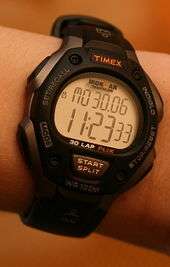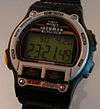Timex Ironman

The Timex Ironman (Ironman-Triathlon) is a digital wristwatch first produced by Timex in 1986 that continues to be made in various styles today.
History and development

In 1984 Timex worked together with the officials of the Ironman Triathlon sporting event to develop a new digital watch to help sagging sales within the company. The result was the Timex Triathlon. In 1986 Timex acquired the rights to the Ironman name, and developed the Ironman Triathlon watch based on the 1984 watch. The basic functions and design were the same as its Triathlon cousin, except that the Ironman was water resistant to 100 meters instead of 50, given an updated look with a black, orange and grey color scheme on the watch face and the 19mm ribbed wrist strap was adorned with the Ironman name and 3 stylized "M" logos. Sales for the new watch grew rapidly; although both models continued in production for many years, Ironman sales much exceeded those of the earlier Triathlon watch. A more dressy silver/stainless steel version was produced a couple of years later. The Ironman Watch includes time, stopwatch (chrono), timer, occasion alarm, and three alarms. The first generation Ironman watches were commonly used by military and law enforcement personnel. A mid-sized, ladies/youth version of the watch was released the same year as the original. The original 1984 Triathlon and 1986 Ironman (full-size/midsize) watches remained in production until 1991, when the first of many cosmetic and design refreshes came along. This era of Timex Ironman is now known amongst watch collectors as the "Pre Indiglo" Ironman.
Indiglo technology
In 1992, the Ironman got its first major technology update since its introduction six years earlier with a new Indiglo electroluminescence technology to replace the mini white corner backlight. Initial runs of the Indiglo Ironmans were the same 1986 design, except they were painted black and silver, given a different wrist strap and were available exclusively at K-Mart before going wide release in early 1993. The original 1986 color scheme Ironman would get the Indiglo backlight at this time as did the Silver/Stainless steel full-size version. The ladies/midsize Ironman would not get the Indiglo technology until 1994. In 1996, Indiglo/TIMEX developed a reflective blue-green or "all-day Indiglo" for its Ironman and other digital watches. This reflective technology has since been adopted by other watch makers and has seemingly been abandoned by Timex as evident in newer (post 2005) releases of its Ironman and other digital watches as they no longer have the reflective screens.
A Presidential watch

U.S. President Bill Clinton owned and wore several early models (including the original) of the watch during his time as Governor of Arkansas and in the early years of his Presidency. In one of his early Presidential photographs, he is seen wearing a blue & black colored Ironman. President Clinton has since donated one of his early Ironman models to the Smithsonian.[1]
Ironman today
The Timex Ironman continues to be Timex's best selling brand. It has been updated over the years, including the Timex Datalink Ironman.
References
- ↑ Mark A. Tabb (1 January 2006). Living With Less: The Upside of Downsizing Your Life. B&H Publishing Group. p. 87. ISBN 978-0-8054-3296-1. Retrieved 18 November 2012.
When Bill Clinton first came to office, he was criticized for wearing a Timex Ironman Decathlon watch rather than a Rolex or some other more “presidential” watch. Clinton's Timex now sits in the Smithsonian Museum. Most people don't care ...